pentax k1000 user manual
The Pentax K1000 is a classic 35mm SLR film camera, renowned for its durability and simplicity. Popular among film enthusiasts, it offers a manual operation with a built-in light meter.
History and Significance of the Pentax K1000
Introduced in 1976, the Pentax K1000 became an iconic 35mm SLR film camera, celebrated for its simplicity, reliability, and durability. Designed to be an affordable yet fully manual camera, it quickly gained popularity among photography students and enthusiasts. Its mechanical design, with a focus on essential features, made it a favorite for learning the fundamentals of photography. Over the years, the K1000 has earned a reputation as a workhorse, with a reputation for durability and compatibility with a wide range of Pentax K-mount lenses. Its significance lies in its ability to provide a hands-on, intuitive shooting experience, free from automation, making it a timeless tool for film photography. Today, it remains a beloved choice for those who cherish the tactile process of shooting with film.
Key Features of the Pentax K1000
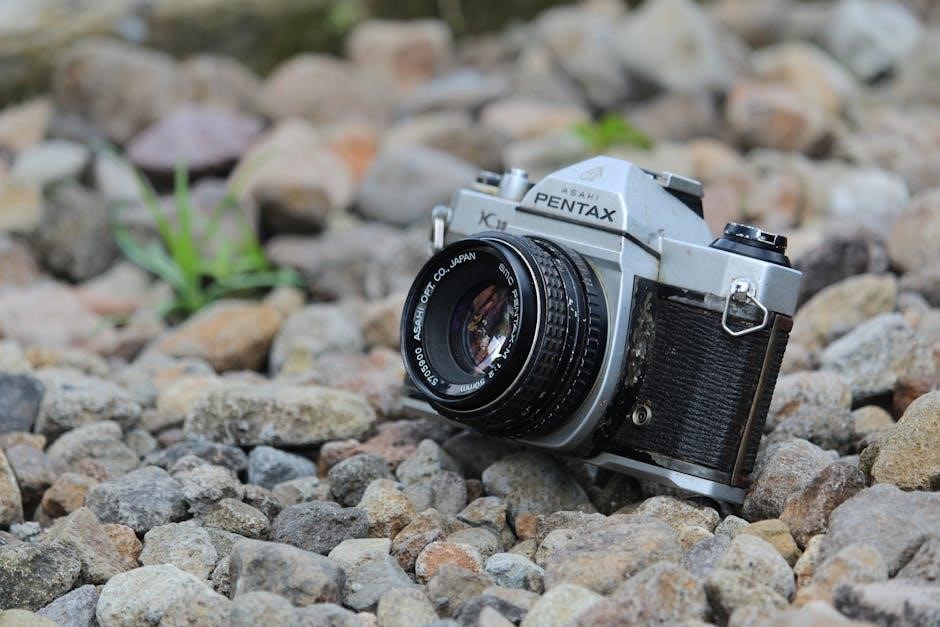
The Pentax K1000 is equipped with a range of features that make it a versatile and user-friendly camera. It features a built-in through-the-lens light meter, which provides accurate exposure readings, and a bayonet (K) mount, allowing compatibility with a wide variety of lenses. The camera offers adjustable ASA/ISO film speeds from 20 to 3200, giving photographers flexibility in different lighting conditions. Shutter speeds range from 1 second to 1/1000th of a second, with a bulb setting for extended exposures. The K1000 also includes a hot shoe for flash photography, enabling the use of external flash units. Its mechanical design ensures that the shutter mechanism operates independently of the battery, making it possible to shoot even when the battery is dead. These features, combined with its durability and simplicity, have made the K1000 a favorite among film photographers for decades.
Why the Pentax K1000 is Popular Among Film Photographers
The Pentax K1000 remains a favorite among film photographers due to its durability, simplicity, and fully manual operation. Its mechanical design, lacking electronic dependencies, ensures reliability and longevity. Photographers appreciate the hands-on experience of manually adjusting aperture, shutter speed, and focus, fostering a deeper connection to the craft. The built-in light meter provides accurate exposure readings, simplifying the process without compromising creative control. Additionally, the K1000’s affordability and compatibility with a wide range of K-mount lenses make it accessible and versatile. Its classic design and robust build resonate with enthusiasts, offering a meditative shooting experience that stands out in today’s fast-paced world. These qualities, combined with a strong community and proven track record, solidify its place as a beloved tool in film photography.

Basic Operating Instructions
Learn essential steps for using the Pentax K1000, including loading film, setting exposure, focusing, and utilizing the built-in light meter for precise control over your photography.
Loading Film into the Pentax K1000
Begin by pulling up the film advance lever to open the camera back. Place the film canister on the left side of the chamber. Pull the film leader and thread it through the take-up spool on the right. Ensure the leader aligns with the red dot on the spool for proper alignment. Close the camera back and advance the film to the first frame using the advance lever. Set the ISO on the lens to match your film speed. This process ensures your camera is ready for shooting. Always load film in low-light conditions to prevent exposure. The K1000’s manual design makes film loading straightforward, allowing you to focus on capturing your shots.
Setting the Exposure: Aperture, Shutter Speed, and ISO
Exposure is controlled by adjusting aperture, shutter speed, and ISO. Aperture (f-stop) regulates light entry, with lower f-stops (e.g., f/2) for more light and higher stops (e.g., f/16) for less. Shutter speed controls exposure duration, with faster speeds (1/1000th of a second) freezing motion and slower speeds (e.g., 1 second) creating blur. ISO sets film sensitivity, with lower values (e.g., ISO 100) for bright light and higher values (e.g., ISO 3200) for low light. The K1000’s light meter helps balance these settings by aligning the viewfinder needle. Adjust aperture or shutter speed until the needle centers for proper exposure. Match the ISO on the lens to your film speed for accurate metering. This manual control allows for creative flexibility in various lighting conditions, making the K1000 a versatile tool for photographers. Proper exposure setup ensures sharp, well-lit images every time.
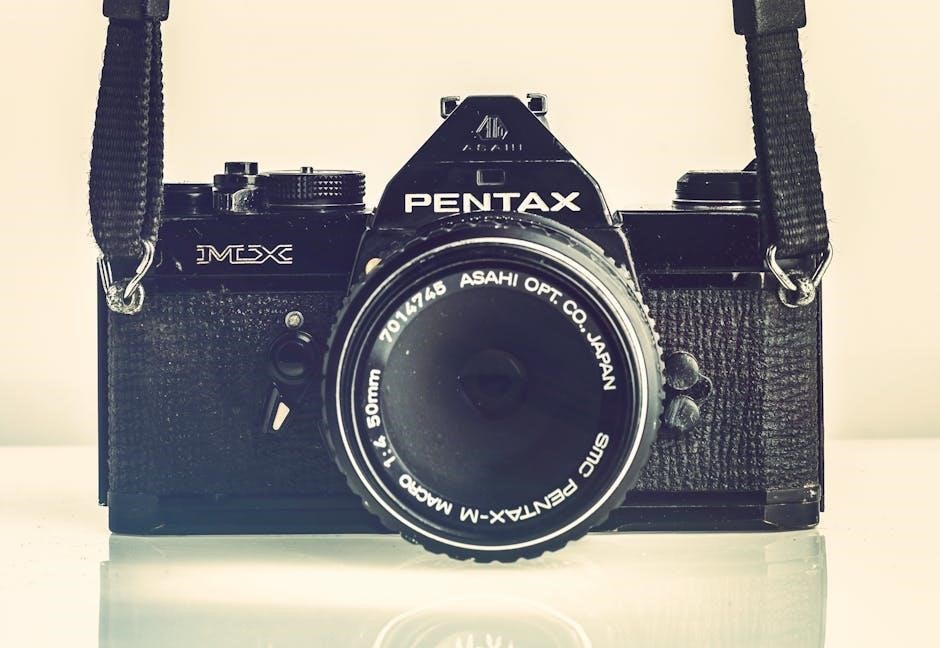
Focusing the Lens for Sharp Images
Focusing the lens on the Pentax K1000 is a manual process that requires precision. The lens features a focusing ring that rotates smoothly, allowing you to adjust the focus by hand. To achieve sharp images, align the subject with the center of the viewfinder and turn the focusing ring until the image appears clear and defined. The K1000’s viewfinder includes a split-image prism and a microprism ring to assist in precise focusing. These aids help ensure that your subject is sharply focused, especially in challenging lighting conditions. For moving subjects, pre-focusing on a specific point in the frame can help capture sharp images. Always use the depth of field preview button to check the focus at the selected aperture. Proper focusing technique is essential for maximizing the camera’s optical performance and producing crisp, detailed photographs.
Using the Built-in Light Meter
The Pentax K1000 features a built-in through-the-lens light meter that simplifies exposure adjustments. To use the meter, ensure the lens cap is removed, as this activates the CdS cells that measure light. In the viewfinder, a needle indicates the optimal exposure by aligning with the center mark. Adjust the aperture or shutter speed until the needle centers, ensuring proper exposure. The meter operates in full-aperture mode, providing accurate readings based on the selected lens. For accurate results, use the meter in various lighting conditions and adjust settings accordingly. If the battery is dead, the needle remains centered, so always check the battery status before shooting. The light meter is powered by a silver oxide battery, which only affects the meter, not the manual shutter operation. Proper use of the light meter ensures well-exposed images, making it an essential tool for achieving consistent results with the K1000.

Advanced Features and Techniques
The Pentax K1000 offers advanced techniques like manual mode, flash photography via the hot shoe, multiple exposures, and infrared photography, providing creative control for experienced photographers.
Manual Mode Operation
Manual mode on the Pentax K1000 offers full control over exposure settings, allowing photographers to adjust aperture, shutter speed, and ISO independently. This mode is ideal for creative photography, enabling precise control over lighting and depth of field. The camera’s built-in light meter assists in determining the correct exposure by displaying a needle that aligns when settings are balanced. Users can achieve desired effects by intentionally overexposing or underexposing images. The manual operation ensures that photographers understand and master fundamental photography principles, making the K1000 a popular choice for educational purposes and artistic expression. The simplicity of its design makes it accessible while providing the flexibility needed for professional results.
Using the Hot Shoe for Flash Photography
The Pentax K1000 features a hot shoe mount, allowing seamless integration with external flash units for enhanced lighting control. To use the hot shoe, simply attach a compatible flash unit, ensuring it is securely locked into place. The camera synchronizes with the flash at shutter speeds up to 1/125th of a second. For optimal results, set the ISO between 100 and 400 and adjust the aperture based on the flash’s guide number. The built-in light meter can help determine the correct exposure when using the flash. Always test the flash synchronization before shooting to ensure proper function. This feature is particularly useful for portrait and low-light photography, offering greater creative flexibility. The hot shoe is compatible with many vintage and modern flash units, making it a versatile tool for photographers.
Multiple Exposure Technique
Achieve creative effects with the Pentax K1000’s multiple exposure feature. To do this, load film as usual and take the first shot. Instead of advancing the film, set the multiple exposure switch, located on the bottom of the camera, to the “M” position. This allows the same frame to be exposed multiple times; After each exposure, the frame counter will not advance, ensuring the same film section is reused. Align compositions carefully to avoid overexposure. Use a tripod for stability and adjust the aperture and shutter speed as needed. Between exposures, ensure no light enters the lens. After the final shot, advance the film and reset the switch. This technique is ideal for artistic overlays, capturing ethereal or abstract imagery. Experiment with different numbers of exposures and subjects for unique results. The K1000’s mechanical design makes it an excellent choice for this manual process.
Infrared Photography with the Pentax K1000
For infrared photography, the Pentax K1000 can produce striking images with proper setup. Use an infrared filter (e.g., R72) and set the ISO to 400 or higher. Mount the filter securely and focus before attaching it, as it reduces visibility. Set aperture to f/5.6 or wider and shutter speed to 1/30s or slower. A tripod and remote shutter release are essential to avoid camera shake. The built-in light meter may not accurately measure IR light, so use an external meter or bracket your shots. IR photography with the K1000 creates unique effects, such as dark skies and white foliage. Experiment with different IR filters and settings to achieve desired results. This technique showcases the camera’s versatility for creative and artistic photography. Always review your results and adjust settings accordingly for optimal outcomes.
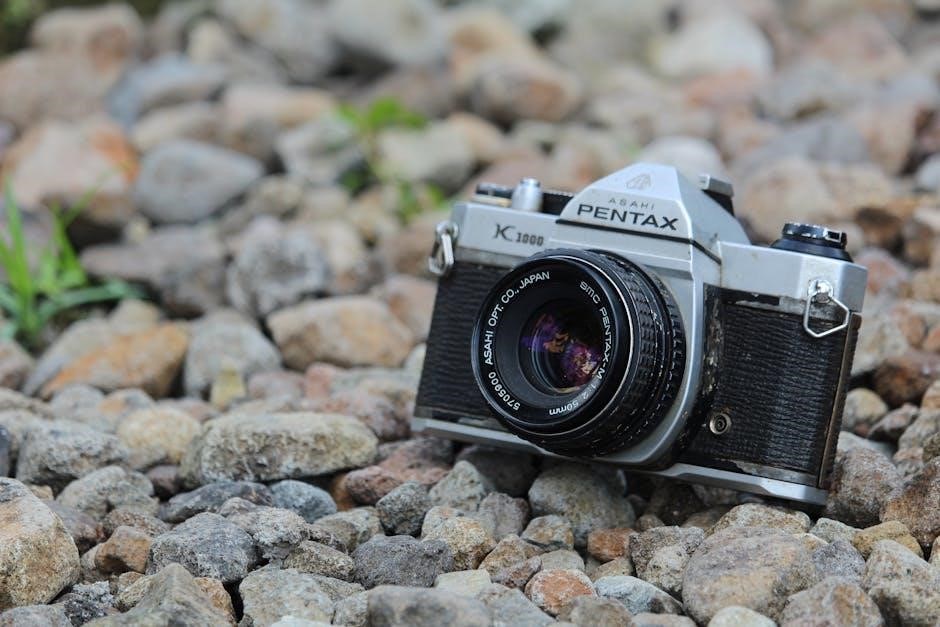
Maintenance and Care
Regularly inspect the Pentax K1000’s shutter and focus for accuracy. Clean with a soft cloth and avoid harsh chemicals. Store in a dry place to prevent moisture damage and ensure longevity.
Cleaning the Camera and Lens
Cleaning the Pentax K1000 and its lens is essential for maintaining image quality. Use a soft, lint-free cloth to wipe the camera body and avoid harsh chemicals. For the lens, gently remove fingerprints with a microfiber cloth and a small amount of lens cleaning solution. Avoid touching the lens surface to prevent smudges. Use a blower or soft brush to remove dust from the mirror and viewfinder. Regular cleaning ensures optimal performance and longevity. Always handle the camera with care to avoid scratches. For internal cleaning, such as the mirror or shutter, consult a professional to prevent damage. Regular maintenance will keep your Pentax K1000 functioning like new and ready for capturing stunning film photography.
Replacing the Battery
To replace the battery in your Pentax K1000, locate the battery compartment on the bottom of the camera. Open it by sliding the cover downward. The camera uses a silver oxide battery (SR44 or equivalent). Turn off the light meter to ensure no power is drawn during replacement. Remove the old battery and dispose of it properly. Insert the new battery with the + terminal facing upward. Close the compartment securely. Test the light meter to confirm it’s functioning correctly. Use only the recommended battery type to avoid damage. Avoid mixing old and new batteries or using rechargeable types. The battery powers the light meter only; the shutter operates manually. Replace the battery every 1-2 years or when the meter needle becomes sluggish. Keep spare batteries handy for extended shoots. Proper battery maintenance ensures accurate exposures and reliable operation. Always handle the battery compartment with care to prevent damage. Regular checks will keep your K1000 performing optimally.
DIY Repairs and Servicing
The Pentax K1000 is durable, but occasional servicing may be needed. DIY repairs include cleaning the mirror, viewfinder, and focal-plane shutter. Use soft brushes or compressed air for cleaning. Light seals can deteriorate over time; replace them with foam strips or adhesive-backed velvet. Lubricate the shutter mechanism sparingly with sewing machine oil. Adjust the light meter calibration if necessary, following online guides. Avoid disassembling complex components like the lens or aperture mechanism; For persistent issues, consult repair manuals or seek professional assistance. Regular servicing ensures optimal performance and extends the camera’s lifespan. Always use genuine parts or compatible replacements. DIY repairs can save costs but require care to avoid further damage. Periodic professional servicing is recommended for thorough maintenance. Keep your K1000 in prime condition with careful attention and timely repairs. This ensures it continues to deliver exceptional results for years to come. Proper servicing is key to maintaining its reliability and functionality.

Troubleshooting Common Issues
Common issues with the Pentax K1000 include a non-working light meter, shutter speed malfunctions, and battery drain. Check battery life, clean electrical contacts, and ensure proper film loading. Regular maintenance andservicing can prevent many problems, ensuring smooth operation. Adjustments may require professional assistance. Always refer to the manual for guidance. Proper care extends the camera’s functionality and reliability. Regular cleaning and inspections help maintain optimal performance. Addressing issues promptly prevents further damage. Troubleshooting guides are available online. Consult repair manuals for detailed solutions. Keep the camera in good condition with routine checks. This ensures consistent results and longevity. Proper handling and storage are essential. Troubleshooting common issues ensures the K1000 continues to perform well. Regular maintenance is key to resolving and preventing problems. Always use genuine parts for repairs. This maintains the camera’s reliability and functionality. Proper care ensures it remains a trusted tool for photography enthusiasts. Troubleshooting common issues ensures the Pentax K1000 continues to deliver exceptional results. Regular servicing and inspections help maintain its performance. Addressing issues promptly prevents further damage. Keep the camera in prime condition with careful attention and timely repairs. This ensures it continues to be a reliable choice for film photography. Proper handling and storage are essential. Troubleshooting common issues ensures the K1000 remains functional and efficient. Regular maintenance is key to resolving and preventing problems. Always use genuine parts for repairs; This maintains the camera’s reliability and functionality. Proper care ensures it remains a trusted tool for photography enthusiasts. Troubleshooting common issues ensures the Pentax K1000 continues to deliver exceptional results. Regular servicing and inspections help maintain its performance. Addressing issues promptly prevents further damage. Keep the camera in prime condition with careful attention and timely repairs. This ensures it continues to be a reliable choice for film photography. Proper handling and storage are essential. Troubleshooting common issues ensures the K1000 remains functional and efficient. Regular maintenance is key to resolving and preventing problems. Always use genuine parts for repairs. This maintains the camera’s reliability and functionality. Proper care ensures it remains a trusted tool for photography enthusiasts. Troubleshooting common issues ensures the Pentax K1000 continues to deliver exceptional results. Regular servicing and inspections help maintain its performance. Addressing issues promptly prevents further damage. Keep the camera in prime condition with careful attention and timely repairs. This ensures it continues to be a reliable choice for film photography. Proper handling and storage are essential. Troubleshooting common issues ensures the K1000 remains functional and efficient. Regular maintenance is key to resolving and preventing problems. Always use genuine parts for repairs. This maintains the camera’s reliability and functionality. Proper care ensures it remains a trusted tool for photography enthusiasts. Troubleshooting common issues ensures the Pentax K1000 continues to deliver exceptional results. Regular servicing and inspections help maintain its performance. Addressing issues promptly prevents further damage. Keep the camera in prime condition with careful attention and timely repairs. This ensures it continues to be a reliable choice for film photography. Proper handling and storage are essential. Troubleshooting common issues ensures the K1000 remains functional and efficient. Regular maintenance is key to resolving and preventing problems. Always use genuine parts for repairs. This maintains the camera’s reliability and functionality. Proper care ensures it remains a trusted tool for photography enthusiasts. Troubleshooting common issues ensures the Pentax K1000 continues to deliver exceptional results. Regular servicing and inspections help maintain its performance. Addressing issues promptly prevents further damage. Keep the camera in prime condition with careful attention and timely repairs. This ensures it continues to be a reliable choice for film photography. Proper handling and storage are essential. Troubleshooting common issues ensures the K1000 remains functional and efficient. Regular maintenance is key to resolving and preventing problems. Always use genuine parts for repairs. This maintains the camera’s reliability and functionality. Proper care ensures it remains a trusted tool for photography enthusiasts. Troubleshooting common issues ensures the Pentax K1000 continues to deliver exceptional results. Regular servicing and inspections help maintain its performance. Addressing issues promptly prevents further damage. Keep the camera in prime condition with careful attention and timely repairs. This ensures it continues to be a reliable choice for film photography. Proper handling and storage are essential. Troubleshooting common issues ensures the K1000 remains functional and efficient. Regular maintenance is key to resolving and preventing problems. Always use genuine parts for repairs. This maintains the camera’s reliability and functionality; Proper care ensures it remains a trusted tool for photography enthusiasts. Troubleshooting common issues ensures the Pentax K1000 continues to deliver exceptional results. Regular servicing and inspections help maintain its performance. Addressing issues promptly prevents further damage. Keep the camera in prime condition with careful attention and timely repairs. This ensures it continues to be a reliable choice for film photography. Proper handling and storage are essential. Troubleshooting common issues ensures the K1000 remains functional and efficient. Regular maintenance is key to resolving and preventing problems. Always use genuine parts for repairs. This maintains the camera’s reliability and functionality. Proper care ensures it remains a trusted tool for photography enthusiasts. Troubleshooting common issues ensures the Pentax K1000 continues to deliver exceptional results. Regular servicing and inspections help maintain its performance. Addressing issues promptly prevents further damage. Keep the camera in prime condition with careful attention and timely repairs. This ensures it continues to be a reliable choice for film photography. Proper handling and storage are essential. Troubleshooting common issues ensures the K1000 remains functional and efficient. Regular maintenance is key to resolving and preventing problems. Always use genuine parts for repairs. This maintains the camera’s reliability and functionality. Proper care ensures it remains a trusted tool for photography enthusiasts. Troubleshooting common issues ensures the Pentax K1000 continues to deliver exceptional results. Regular servicing and inspections help maintain its performance. Addressing issues promptly prevents further damage. Keep the camera in prime condition with careful attention and timely repairs. This ensures it continues to be a reliable choice for film photography. Proper handling and storage are essential. Troubleshooting common issues ensures the K1000 remains functional and efficient. Regular maintenance is key to resolving and preventing problems. Always use genuine parts for repairs. This maintains the camera’s reliability and functionality. Proper care ensures it remains a trusted tool for photography enthusiasts. Troubleshooting common issues ensures the Pentax K1000 continues to deliver exceptional results. Regular servicing and inspections help maintain its performance. Addressing issues promptly prevents further damage. Keep the camera in prime condition with careful attention and timely repairs. This ensures it continues to be a reliable choice for film photography. Proper handling and storage are essential. Troubleshooting common issues ensures the K1000 remains functional and efficient. Regular maintenance is key to resolving and preventing problems. Always use genuine parts for repairs. This maintains the camera’s reliability and functionality. Proper care ensures it remains a trusted tool for photography enthusiasts. Troubleshooting common issues ensures the Pentax K1000 continues to deliver exceptional results. Regular servicing and inspections help maintain its performance. Addressing issues promptly prevents further damage. Keep the camera in prime condition with careful attention and timely repairs. This ensures it continues to be a reliable choice for film photography. Proper handling and storage are essential. Troubleshooting common issues ensures the K1000 remains functional and efficient. Regular maintenance is key to resolving and preventing problems. Always use genuine parts for repairs. This maintains the camera’s reliability and functionality. Proper care ensures it remains a trusted tool for photography enthusiasts.
Light Meter Not Working
If the light meter in your Pentax K1000 is not functioning, it could be due to a dead battery or corroded contacts. The meter relies on a silver oxide battery to operate, and if the battery is depleted, the needle will remain centered. Clean the battery compartment and contacts with a soft cloth or alcohol to ensure proper connectivity. Ensure the lens cap is removed, as this activates the meter circuit. If issues persist, replace the battery with a fresh one. Avoid using a mercury battery, as it may damage the meter. If the problem continues, check for dirt or debris in the metering system. Gently clean the CdS cells with a soft brush or swab. If the meter still doesn’t work, consult a professional for repair. Always refer to the manual for guidance on troubleshooting and maintenance.
Shutter Speed Malfunction
If the shutter speed on your Pentax K1000 is malfunctioning, it may be due to mechanical wear or dirt within the mechanism. Start by cleaning the camera thoroughly, especially around the shutter curtains. Ensure the battery is functional, as the light meter depends on it, though the shutter itself operates manually. If the shutter sticks or doesn’t close properly, try exercising it by firing several frames without film. For persistent issues, inspect the curtains for tears or debris. Lubricate the shutter mechanism only if experienced, as improper lubrication can cause further damage. If the problem persists, seek professional servicing, as internal repairs can be complex. Always handle the shutter mechanism with care to avoid causing permanent damage. Regular maintenance can help prevent malfunctions and ensure smooth operation. Keep the camera clean and store it in a dry environment to prolong its functionality.
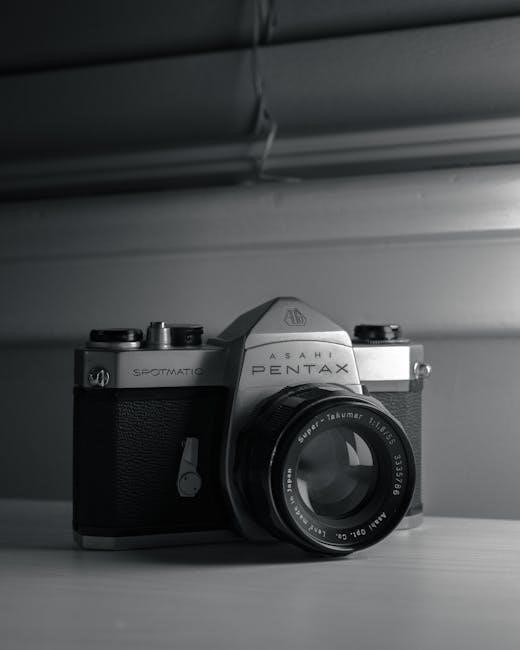
Compatibility and Accessories
The Pentax K1000 supports a wide range of K-mount lenses and accessories, enhancing its versatility for various photography needs. It is compatible with multiple flash units, providing flexibility in lighting setups.
Compatible Lenses for the Pentax K1000
The Pentax K1000 uses the versatile K-mount system, allowing compatibility with a vast range of lenses. This includes both older manual-focus lenses and newer autofocus models. The standard 50mm f/1.7 lens is a popular choice, offering excellent image quality and low-light performance. Photographers can also explore wide-angle lenses like the 28mm f/2.8 or telephoto options such as the 70mm f/2.8 for diverse shooting needs. Additionally, third-party lenses from brands like Sigma and Tamron are compatible, providing budget-friendly alternatives. The K-mount system ensures that users can easily switch lenses, making the K1000 adaptable for various photography styles and preferences. This compatibility has made the K1000 a favorite among enthusiasts and professionals alike, ensuring its longevity in the world of film photography;
Recommended Flash Units
The Pentax K1000 is compatible with a variety of flash units, enhancing its versatility in low-light conditions. The built-in hot shoe allows seamless connection with flashes like the Pentax AF-240FT, AF-280T, and AF-540FGZ, which offer advanced features such as TTL metering and bounce capabilities; For those seeking affordability, third-party flashes from brands like Vivitar and Sunpak are excellent options. These units provide reliable performance and are widely available. When using manual flashes, ensure they are set to the correct sync voltage to avoid damaging the camera. The K1000’s compatibility with both modern and vintage flash units makes it a flexible choice for photographers. This adaptability ensures that users can achieve professional-grade results in various lighting scenarios, maintaining the camera’s reputation as a versatile tool for film photography enthusiasts.
The Pentax K1000 remains a timeless choice for film photography, cherished for its reliability and creative control. Embrace its manual operation to unlock your full photographic potential.
Legacy of the Pentax K1000 in Film Photography
The Pentax K1000 holds a revered place in film photography history, known for its durability and simplicity. It introduced many to manual photography and remains a favorite among enthusiasts. Its K-mount compatibility offers lens versatility, supporting both vintage and modern optics. The camera’s mechanical reliability ensures it continues to function decades after production. Its impact is evident in the thriving community of users and collectors. The K1000’s timeless design and functionality make it a cornerstone in the evolution of SLR cameras, preserving the art of film photography for future generations.
Final Tips for Getting the Most Out of Your Pentax K1000
To maximize your experience with the Pentax K1000, experiment with different film stocks to find your preference. Regularly clean the lens and camera body to maintain image quality. Familiarize yourself with manual controls for precise exposures. Shoot in various lighting conditions to understand how aperture, shutter speed, and ISO interact. Practice the zone system for black-and-white photography. Use a tripod for long exposures and low-light shots. Explore creative techniques like multiple exposures and infrared photography. Engage with online communities to share knowledge and learn from other users. Lastly, ensure proper battery maintenance, as the light meter relies on it. With dedication and practice, the K1000 will become an extension of your creative vision, offering endless possibilities in film photography.
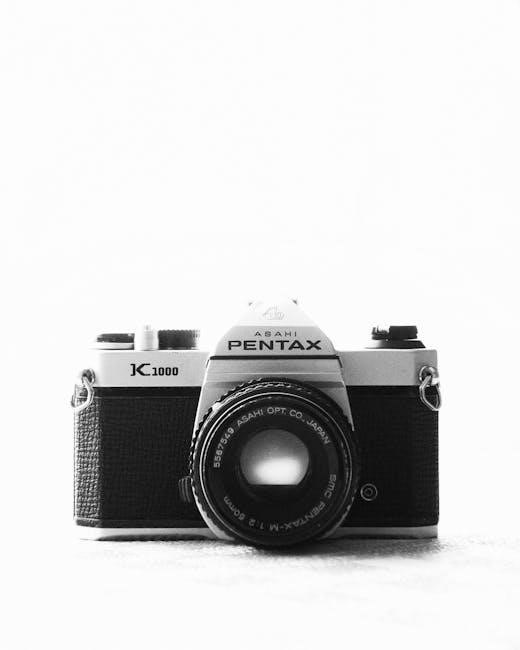
Additional Resources
Find the full Pentax K1000 manual at cameramanuals.org. Join online forums like PentaxForums.com for tips, troubleshooting, and community support.
Where to Find the Full Pentax K1000 User Manual
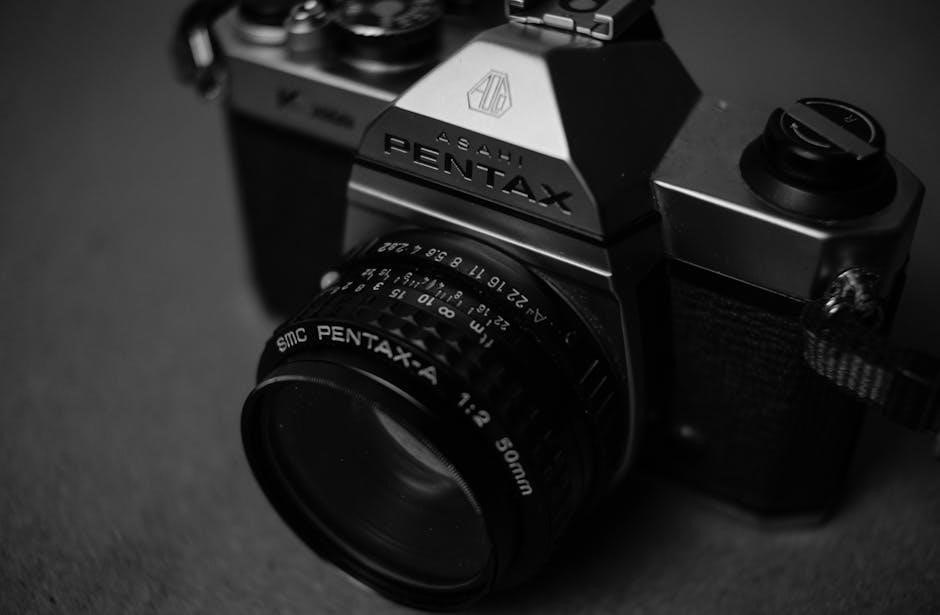
The full Pentax K1000 user manual is available for free download as a PDF from various online sources. One reliable source is cameramanuals.org, where you can find the official manual in English. The manual is 12.8 MB in size and was uploaded in 2020. It covers all essential features, including the built-in light meter, K-mount lens compatibility, and film speed adjustments. Additionally, it provides step-by-step guides for loading film, setting exposure, and using the flash. The manual is a valuable resource for both beginners and experienced photographers, offering detailed instructions and troubleshooting tips. For further assistance, you can also explore forums and communities dedicated to Pentax K1000 users, where members often share their experiences and advice.
Online Communities and Forums for Pentax K1000 Users
Online communities and forums dedicated to the Pentax K1000 are invaluable resources for users seeking advice, troubleshooting, and inspiration. Websites like 35mmc.com and dedicated Pentax forums host extensive discussions on film photography, camera maintenance, and creative techniques. These platforms are frequented by both seasoned photographers and newcomers, offering a wealth of shared knowledge and experiences. Many users post reviews of compatible lenses and flash units, while others share tips for achieving optimal results with the K1000. Additionally, these communities often feature galleries showcasing stunning images captured with the camera, providing inspiration for your own photography projects. Whether you’re looking for technical guidance or creative ideas, these online forums are a fantastic way to connect with fellow Pentax K1000 enthusiasts.

